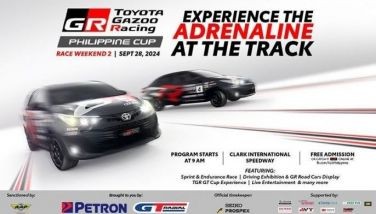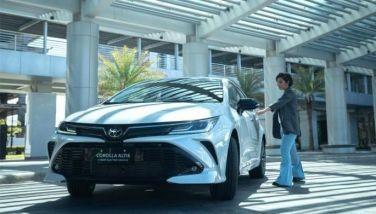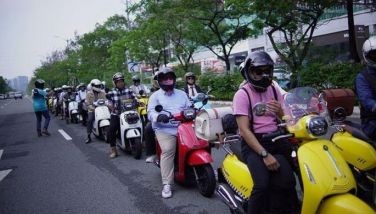Tips on motorcycle safety
November 13, 2002 | 12:00am
Each year, approximately 5,000 Filipino motorcyclists are either injured or killed in traffic crashes. The injuries and deaths, however, could have been prevented if bike riders and their passengers practiced safe riding techniques. Accidents involving motorcycles could be entirely avoided and reduced to zero.
"Just like when you first learned to drive a car, you were taught about defensive driving. The same thing goes for motorcycle riding where the riders practice risk management," says Mateo Ocenar, chairman of the Motorcycle Development Program Participants Association Inc. (MDPPA).
The MDPPA, an association of legitimate motorcycle manufacturers like Honda Phils. Inc., Kawasaki Motor (Phils.) Corp., Norkis Trading Co. Inc. (Yamaha), Porta Coeli Industrial Co., S.C. Kymco Pilipinas Inc. and Suzuki Phils. Inc., strongly advocates motorcycle safety to all its customers.
Riding safely is mostly a matter of knowledge and attitude. The MDPPA is offering these pointers to keep you safe and make bike riding most exciting and pleasantly enjoyable:
• If you ride a motorcycle, protect yourself properly. Helmets are your best defense against serious and fatal brain injuries. In addition to your helmet, wear eye and face protectors. Many helmets have built-in visors or other face guards. Passengers who ride with you must wear helmets and protective gear. When riding, safety experts advise you to don long pants, gloves, boots and a durable, long-sleeved jacket. Wear colorful clothes so other motorists can easily see you on the road; placing stickers on your bike that are colorful, luminous or reflectorized also helps. If possible, always turn your headlights on. Other countries in Asia have enacted laws making Day-time Running Light (DRL) mandatory.
Insist that passengers sit behind you on the motorcycle. Make sure passengers’ feet can reach the footrests and that they keep their feet on the footrests at all times, even when you stop. Tell them to lean with you when you turn and hold on to your waist all the time. Since riding needs concentration, ask your passengers to limit their movement and talking.
• Look where you want to go. There is no doubt that one‘s motorcycle does, indeed, go where one looks. This tendency for motorcycles to run into things the rider fixes his/her eyes on is called target fixation.
A classic example of target fixation lies in the very high number of motorcycle fatalities involving riders who run into lampposts, usually when the rider’s motorcycle fails to get round a corner. Just imagine how narrow a motorcycle is and how very narrow a lamppost is. Yet the motorcycle impacts into the lamppost with deadly accuracy. The reason is, of course, the rider looks at the lamppost, thinks "Gee, I don’t want to hit that," clamps his eyes on the threatening object – and promptly runs into it.
Perhaps not surprisingly, the solution to the problem also lies on turning your head and looking at the road where you want to go. Most of the time, this will work. Your bike will prove to have more in reserve than you thought and it will get around the corner and head where you want it to go. And even if it doesn’t get around the corner, you are more likely to low side (the bike falls down and you slide off it and slide to a shocked stop) than the impact upright into the deadly, unmoving lamppost.
• Keep your distance and control the speed demon. Admittedly, motorcycles offer more mobility and you can pass through any obstacle without a hitch. But sometimes, we tend to stick closely to the vehicle in front of us or try to prove who’s the fastest one on the road. These are arguably two of the greatest sins committed by riders on a regular basis. When traveling on the highway, the minimum distance to keep between you and the vehicle in front is two to four seconds, which is enough reaction time to stop. At night or during rainy days, your distance should be four to eight seconds. Don’t over-speed because this will only lead to more troubles and you’ll either end up with bruises and broken bones or worse, you’re dead. Remember, riding motorcycles like bicycles don’t kill. But speed does.
• Ride with great attitude. Respect all those who are on or off the road. Always remember that there are thousands of other vehicles using the road to reach their destinations. Be considerate to pedestrians when they cross the road. By having the right attitude, you’re doing your part in promoting motorcycles as a safe means of transportation to the public. "Taking any motorcycle-training course is an advantage. Always remember that the cornerstones to safe motorcycling are knowledge, training, attitude and practice. These are what makes a good rider," Ocenar says.
"Just like when you first learned to drive a car, you were taught about defensive driving. The same thing goes for motorcycle riding where the riders practice risk management," says Mateo Ocenar, chairman of the Motorcycle Development Program Participants Association Inc. (MDPPA).
The MDPPA, an association of legitimate motorcycle manufacturers like Honda Phils. Inc., Kawasaki Motor (Phils.) Corp., Norkis Trading Co. Inc. (Yamaha), Porta Coeli Industrial Co., S.C. Kymco Pilipinas Inc. and Suzuki Phils. Inc., strongly advocates motorcycle safety to all its customers.
Riding safely is mostly a matter of knowledge and attitude. The MDPPA is offering these pointers to keep you safe and make bike riding most exciting and pleasantly enjoyable:
• If you ride a motorcycle, protect yourself properly. Helmets are your best defense against serious and fatal brain injuries. In addition to your helmet, wear eye and face protectors. Many helmets have built-in visors or other face guards. Passengers who ride with you must wear helmets and protective gear. When riding, safety experts advise you to don long pants, gloves, boots and a durable, long-sleeved jacket. Wear colorful clothes so other motorists can easily see you on the road; placing stickers on your bike that are colorful, luminous or reflectorized also helps. If possible, always turn your headlights on. Other countries in Asia have enacted laws making Day-time Running Light (DRL) mandatory.
Insist that passengers sit behind you on the motorcycle. Make sure passengers’ feet can reach the footrests and that they keep their feet on the footrests at all times, even when you stop. Tell them to lean with you when you turn and hold on to your waist all the time. Since riding needs concentration, ask your passengers to limit their movement and talking.
• Look where you want to go. There is no doubt that one‘s motorcycle does, indeed, go where one looks. This tendency for motorcycles to run into things the rider fixes his/her eyes on is called target fixation.
A classic example of target fixation lies in the very high number of motorcycle fatalities involving riders who run into lampposts, usually when the rider’s motorcycle fails to get round a corner. Just imagine how narrow a motorcycle is and how very narrow a lamppost is. Yet the motorcycle impacts into the lamppost with deadly accuracy. The reason is, of course, the rider looks at the lamppost, thinks "Gee, I don’t want to hit that," clamps his eyes on the threatening object – and promptly runs into it.
Perhaps not surprisingly, the solution to the problem also lies on turning your head and looking at the road where you want to go. Most of the time, this will work. Your bike will prove to have more in reserve than you thought and it will get around the corner and head where you want it to go. And even if it doesn’t get around the corner, you are more likely to low side (the bike falls down and you slide off it and slide to a shocked stop) than the impact upright into the deadly, unmoving lamppost.
• Keep your distance and control the speed demon. Admittedly, motorcycles offer more mobility and you can pass through any obstacle without a hitch. But sometimes, we tend to stick closely to the vehicle in front of us or try to prove who’s the fastest one on the road. These are arguably two of the greatest sins committed by riders on a regular basis. When traveling on the highway, the minimum distance to keep between you and the vehicle in front is two to four seconds, which is enough reaction time to stop. At night or during rainy days, your distance should be four to eight seconds. Don’t over-speed because this will only lead to more troubles and you’ll either end up with bruises and broken bones or worse, you’re dead. Remember, riding motorcycles like bicycles don’t kill. But speed does.
• Ride with great attitude. Respect all those who are on or off the road. Always remember that there are thousands of other vehicles using the road to reach their destinations. Be considerate to pedestrians when they cross the road. By having the right attitude, you’re doing your part in promoting motorcycles as a safe means of transportation to the public. "Taking any motorcycle-training course is an advantage. Always remember that the cornerstones to safe motorcycling are knowledge, training, attitude and practice. These are what makes a good rider," Ocenar says.
BrandSpace Articles
<
>
- Latest
Latest
Latest
September 30, 2024 - 4:26pm
By EC Toledo | September 30, 2024 - 4:26pm
September 26, 2024 - 3:30pm
September 26, 2024 - 3:30pm
August 16, 2024 - 11:00am
By Euden Valdez | August 16, 2024 - 11:00am
Recommended
December 30, 2024 - 12:00am
December 29, 2024 - 12:00am
December 27, 2024 - 12:00am

























